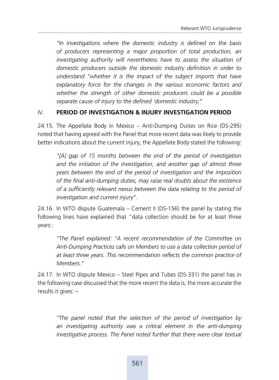Page 584 - MANUAL OF SOP
P. 584
Relevant Wto Jurisprudence
“In investigations where the domestic industry is defined on the basis
of producers representing a major proportion of total production, an
investigating authority will nevertheless have to assess the situation of
domestic producers outside the domestic industry definition in order to
understand "whether it is the impact of the subject imports that have
explanatory force for the changes in the various economic factors and
whether the strength of other domestic producers could be a possible
separate cause of injury to the defined 'domestic industry.”
IV. PERIOD OF INVESTIGATION & INJURY INVESTIGATION PERIOD
24.15. The Appellate Body in Mexico – Anti-Dumping Duties on Rice (DS-295)
noted that having agreed with the Panel that more recent data was likely to provide
better indications about the current injury, the Appellate Body stated the following:
"[A] gap of 15 months between the end of the period of investigation
and the initiation of the investigation, and another gap of almost three
years between the end of the period of investigation and the imposition
of the final anti-dumping duties, may raise real doubts about the existence
of a sufficiently relevant nexus between the data relating to the period of
investigation and current injury”.
24.16. In WTO dispute Guatemala – Cement II (DS-156) the panel by stating the
following lines have explained that “data collection should be for at least three
years::
“The Panel explained: "A recent recommendation of the Committee on
Anti-Dumping Practices calls on Members to use a data collection period of
at least three years. This recommendation reflects the common practice of
Members.”
24.17. In WTO dispute Mexico – Steel Pipes and Tubes (DS-331) the panel has in
the following case discussed that the more recent the data is, the more accurate the
results it gives: –
“The panel noted that the selection of the period of investigation by
an investigating authority was a critical element in the anti-dumping
investigative process. The Panel noted further that there were clear textual
561

